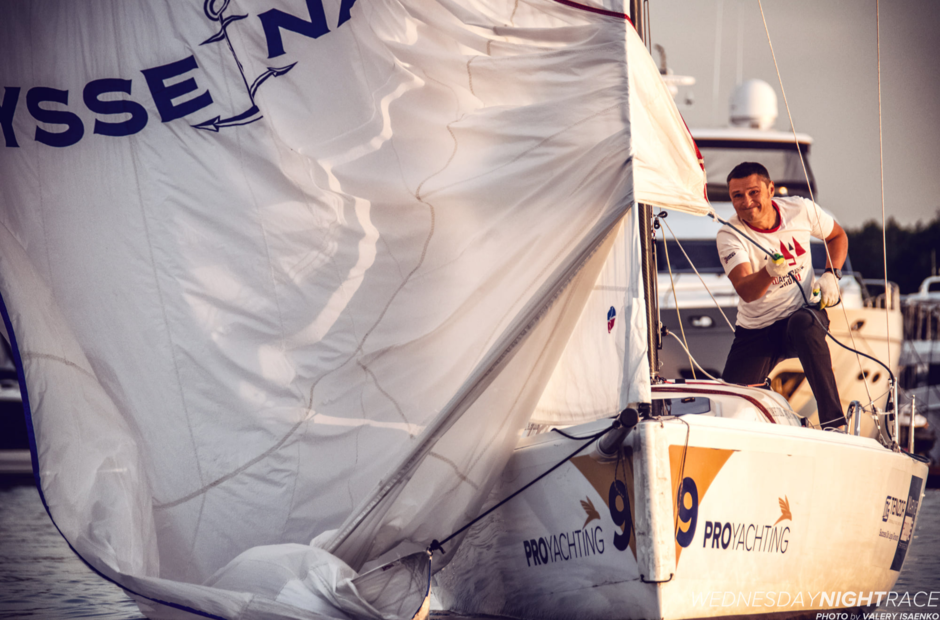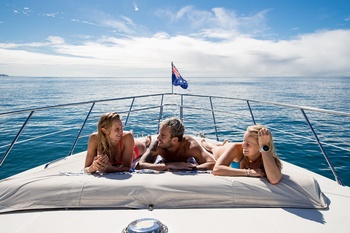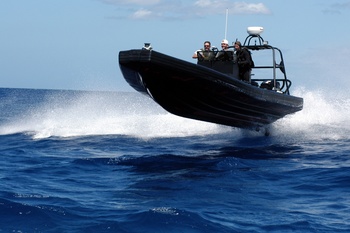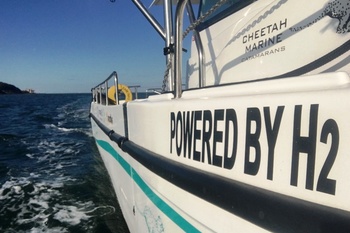One or two masts? What kind of sails are there and how many should there be?
In order to successfully answer these questions, it is advisable to get acquainted with basic concepts and definitions to begin with. So...
What is included in the notion «sailing armament»
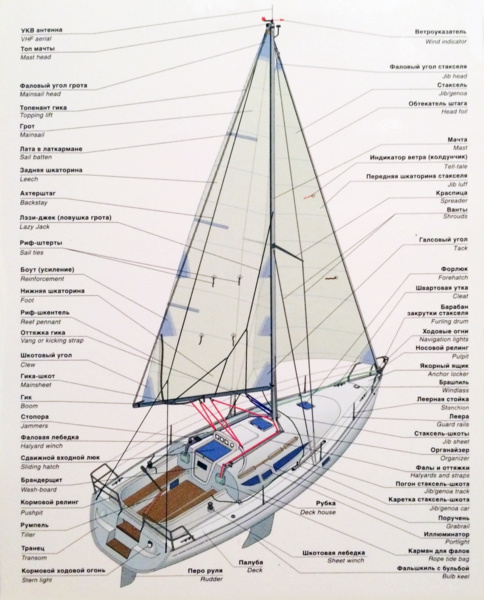
Sail armament (or in other words, sailcloth) is not only sails themselves but also all the objects and devices which are involved in setting, cleaning and managing sails.
Speaking yachting parlance, sails' rigging is the sails, spar and rigging.
Spars areall rigid structures which are used for rigging and maintenance of sails. The mast, the boom, the batten and the bowsprit are all spars. Elements of the spar can be either fixed or pivoting.
Rigging is all ropes (tackle), elements and systems of their fastening. A distinction is made depending on the purpose:
- Standing rigging - tackles for supporting (securing) the spars. In general case (see figure), their set includes: booms (fore-and-aft) to hold the mast in the longitudinal plane and battens (in transverse). After initial installation and adjustment (tightening), the position of the standing rigging usually does not change.
- Running rigging is rigging of ropes for lifting/lowering of sails and individual parts of rigging and for changing their position relatively to longitudinal (diametrical) plane of a vessel. Main elements of running rigging and their functions:
- Halyards - hoisting/declining of sails, spars, flag and other signals.
- Halyards - control of sails and spars (e.g. booms), «responsible» for turning the sail.
- Tacks - pulling and attaching the rear (tack) corner of the sail to the deck (boom, bowsprit).
- Topenants - keeping the end (toe) of the boom horizontal while underway or at anchorage. Large boats usually have two topenants for each boom.
- Bras are for turning the sail horizontally. For example, the spinnaker control spar (spinnaker boom) is attached by a counter batten set in the bow of the boat.
- Reef-staves and reef-staves are short cables (ends) which are used for decreasing the working area (reefing) of the sail in case of wind increase. They come out of wide use as modern technologies for performing this operation of sails (reefers, patent reefers) are developed.
The main secret of a successful boat is to choose the right hull and equip it with optimal sailing equipment. So what are the options for this?
How to calculate the optimal sail area
In theory, the bigger the total sail area, the faster the boat can reach speed. Such discrepancy between the area of sail and the total boat weight guarantees annoying troubles: shortage of sails doesn't let the boat to win the race, and excess of them threatens with the loss of rigging and even capsizing of the boat.
The bigger working area of the hoisted sails, the bigger is the load on masts and their supporting rigging. As a result, strong gust of wind (squall) may break the mast(s) or turn it out of its anchoring (staysail), breaking its fasteners (staysails, booms). If the mast does hold, the increased heeling moment can cause the boat to keel over or turn over.
When calculating the optimum area for the sail rig, the following must be taken into account:
- The purpose of the boat - for short family outings, cruising or racing.
- Area of use - inland waterways, coastal marine area, ocean expanses.
- Displacement, dimensions, type and weight of ballast/fallow, hull shape.
- Constructional peculiarities: material of hull and spars, height of freeboard, bulwark, etc.
General rule: the bigger the displacement a yacht has, the bigger the sail area it will be able to carry considering the intended navigation area.
For example, the sail area for large oceangoing yachts (3-15 tons) is 30-100 m2 and more, for sea-going yachts - from 25 to 90 m2, and for coastal boats usually it doesn't exceed 60-70 m2.
«The exact calculation of total sail area for every boat is done individually and based on the received data recommendations for proper selection of» (type, shape, size/level of sail) for its sailing in different weather conditions are formed.
Types of Sailing Equipment by Shape and Mounting Method of the Mainsail
A man has always tried to simplify the sail control to the maximum, minimizing the size of spars and the number of gears necessary for it. As a result, a powerful batten which was necessary for setting a straight sail was replaced by a comparatively small tilting batten with the lower end fixed by a tack. The sail itself has slightly decreased in size and got a trapezoidal shape. Then evolution divided the batten into two parts - upper (gaff and its varieties) and lower (boom) - while the sail was divided into a bigger aft one and a smaller fore one. A variant in which the lower end of the aft sail was attached to the sloping rod - sprint - turned out to be an intermediate link. Nowadays railed sails for yachting are a thing of the past, and sprinter sails can be found only on dinghies like «Optimist».
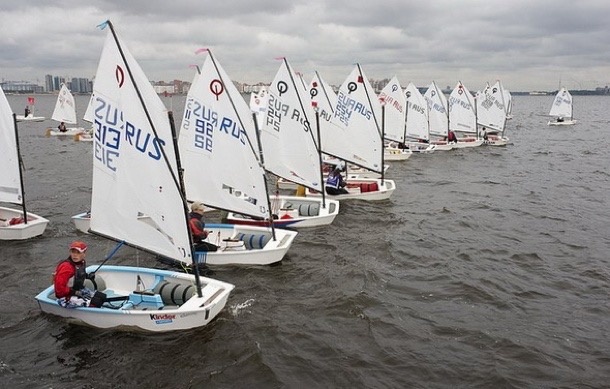
Gaffel sails are much luckier: though new boats are being equipped with them very seldom, such rigging can still be found on boats, mainly designed for touring.
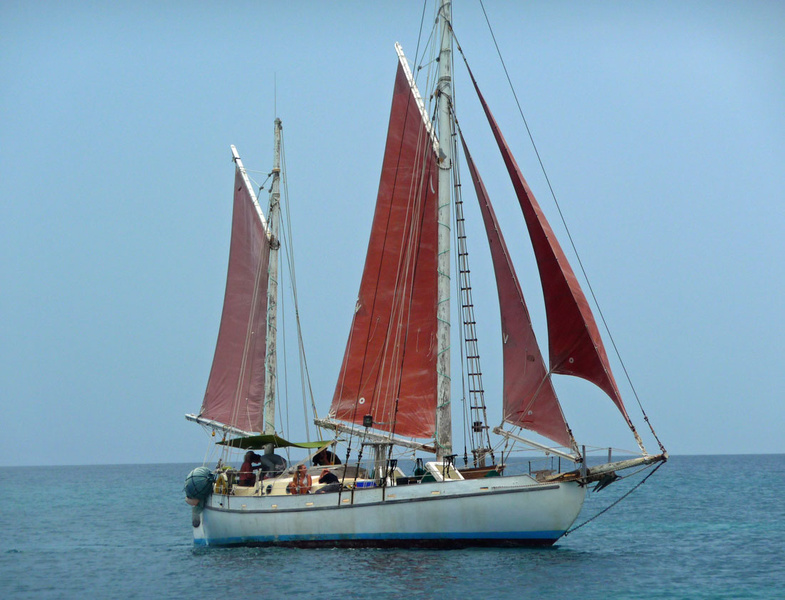
An interesting evolutionary step in the development of the gaff is the square top version, where the upper part of the sail is stretched almost perpendicular to the mast with a relatively short stem. Due to this the sail area is significantly increased and the efficiency of sail handling is significantly increased even in relatively weak winds. Such a solution is especially popular in racing boats, as it allows you to carry a larger sail area without increasing the height of the mast.
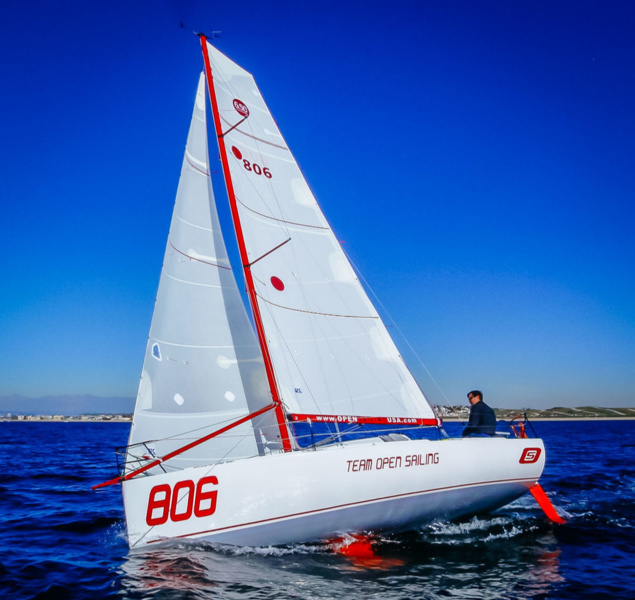
But with the overwhelming majority of modern boats, the so called Bermuda sails are used as the main backsails which got their name after the place of their origin - from fishermen of Bermuda Islands.
The sail does not need a gaff, as its upper (halyard) corner is set on the mast top, and the lower edge (luff) is stretched on the pivot spar (boom). As these sails are reminiscent of the first radio transmitter antennas by their specific shape, they are sometimes also called «Marconi sails».
The most common variant of yacht outfitting these days is the Bermuda sloop.
It is a single-masted boat with a triangular mainsail and a versatile set of forward sails designed for different sailing conditions.
Let's take a closer look at what a typical modern sailing wardrobe consists of.
Types of Sails and Their Features
A mainsail is a triangular sail with the upper end and leading edge (scale) attached to the mast while the lower end is set on a horizontally positioned spar - boom. In most cases, it is the biggest sail in terms of area, which on modern boats is furled either into a mast (In-mast furling) or into a boom (In boom furling) on a special furling bar. Besides providing great propulsive force, the mainsail provides efficient airstream service for the forward sails, and helps to keep the rudder balance. The set usually includes two main mainsails (the spare is kept ashore on shorter cruises) and a smaller storm mainsail.
A staysail is also a triangular sail, the leading edge of which is attached to an inclined rope (tripod). In the Bermuda version, it is the main fore sail which area can be from 30% to 40% (on cruising boats) to 60% (on racing boats) of the boat's total sail area. «In the latter case, it works as the main working wing», which gives the boat the most significant thrust. Depending on size and shape, jibs are divided into several types, designed to be used in different weather conditions. An important additional characteristic is the percentage ratio of the sail area to the area of the triangle formed by the mast, mainsail and the stretch of deck to the place where the latter is fastened. So, the terms «40%» or «75%» mean that the sail covers respectively just under half or 2/3 of the area between the boom and the mast. According to their size, they are all numbered as well, with number 1 being the largest sail area.
A genoa is a large and wide jib designed to make effective use of weak winds. When a full genoa is set, its lower (sheet) corner reaches the mast or even goes behind it. An overlapping genoa is a genoa with a ratio of more than 100%, which actually overlaps the foremost luff of the mainsail. In a long sailing boat, it is advisable to have three genii, which are also numbered from larger to smaller:
- No.1 (140-150%) with a low scuttle angle. Usually used in winds up to 2 points on courses from gulfwind to sharp reefing.
- No.2 (up to 120%) - in 2 to 4 gusts of wind on the same course.
- No.3 (100%) - for 4-5 point winds, at courses from gulfind to baydeck.
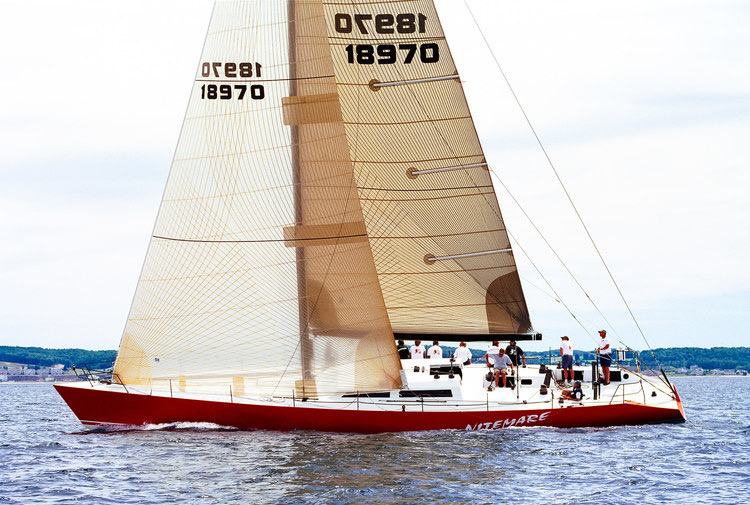
Headsail Automatic is a medium size sail when sailing with frequent tack changes on sharper fairways. It features a deck-mounted chase (A) on which a special carriage (B) moves with a staysail skewed through blocks (C and D). A change of tack requires only a simple tilt of the rudder and the jib will move on to the required side.
Along with automatic jibs, solo sailors often use the jib option when tacking. Specifically, Viktor Yazykov chose such a solution for his «Daughter of the Wind».
The Storm jib is the smallest (up to 20%, but in general the smaller the better) in size, with a high sheet angle, also called «nosegay». It is designed to be set for long periods in strong winds and provides the boat with the necessary steering while minimizing the load on the mast and rudder. As a rule, it is the only sail which is worth carrying in wind speeds over 7. It can be set on the main bow or on the auxiliary (so called "baby") boom.
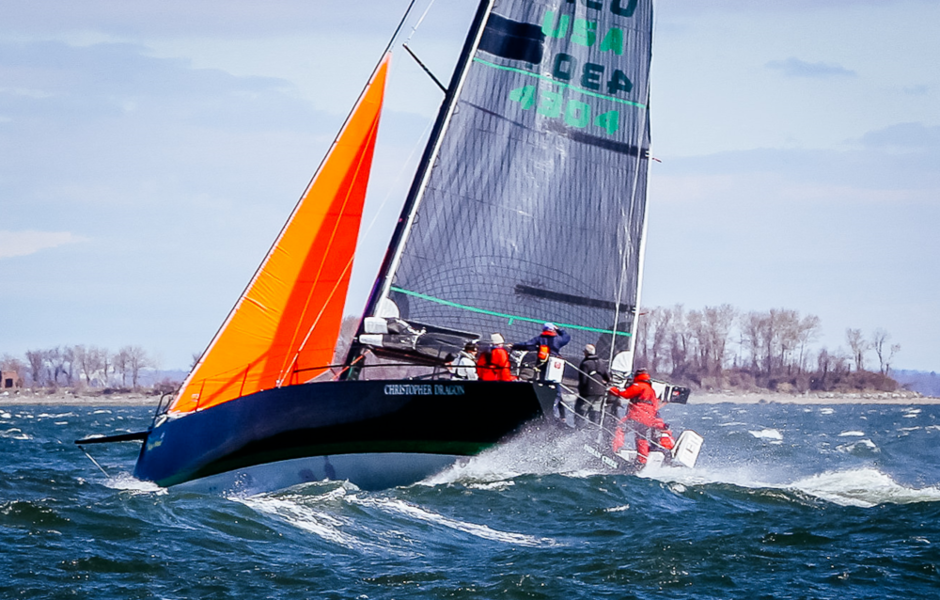
Spinnaker - a large sail made of light cloth with a semi-circular profile. Usually, it is used in light and moderate crosswinds, on courses from downwind to gulfwind. Eric Tabarley's experience « has contributed to the spinnaker's popularity:» his Rep Duick V, the 1969 Pacific Race winner, had three such sails, 60, 88 and 120 m2, in his wardrobe. The spinnaker is set on the mainsail (with the jib usually lowered). The sail is set at the head (halyard) corner with the windward end further supported by a spinnaker jib. The sail is steered with braces and special luffs. Spinnaker is pretty pretty and it squeezes out the wind quite effectively, but setting/clearing it as well as manoeuvring under it requires a lot of experience. Only a professional sailor could manage to set it alone - that's why charter companies prefer not to include spinnaker in the set of sails for charter boats.
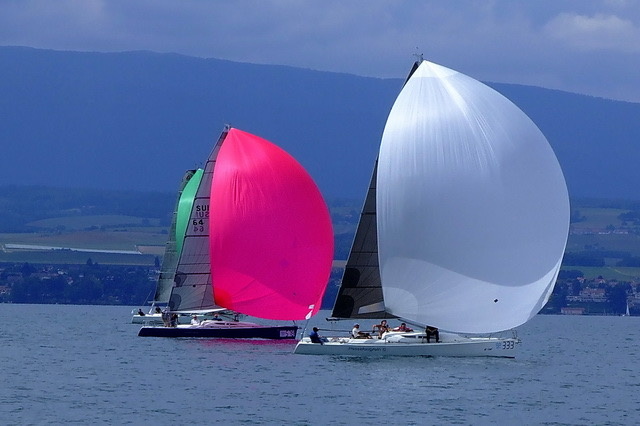
Genaker (aka asymmetrical spinnaker) - as the name suggests, the sail is an attempt to combine the ease of handling of a genoa and the advanced capabilities of a spinnaker. It is larger than the former and inferior to the latter. Unlike the spinnaker, the gennaker can be stored in a twist on a separate boom, making it much easier to set. The tacker is fixed on the boat's bow or attached to the bowsprit (including the retractable one), and it is controlled by the whipstaff, led to the third (sheet) corner. No additional spar is needed for this, but to increase the efficiency in very weak winds, the gennaker can be set with a spinnaker jib on the side opposite the mainsail (setting «butterfly»). This sail is applicable in a wider range of courses than the spinnaker. So, under a relatively «flat» genaker you can sail even on a full reach (instead of a jib). It's easier to sail in butterfly lane and easier to maintain, but it also needs some practice to be successful. Despite all its advantages it has an important disadvantage: Genaker is very difficult to sail downwind, so even in tailwind you have to choose backstretch sails.
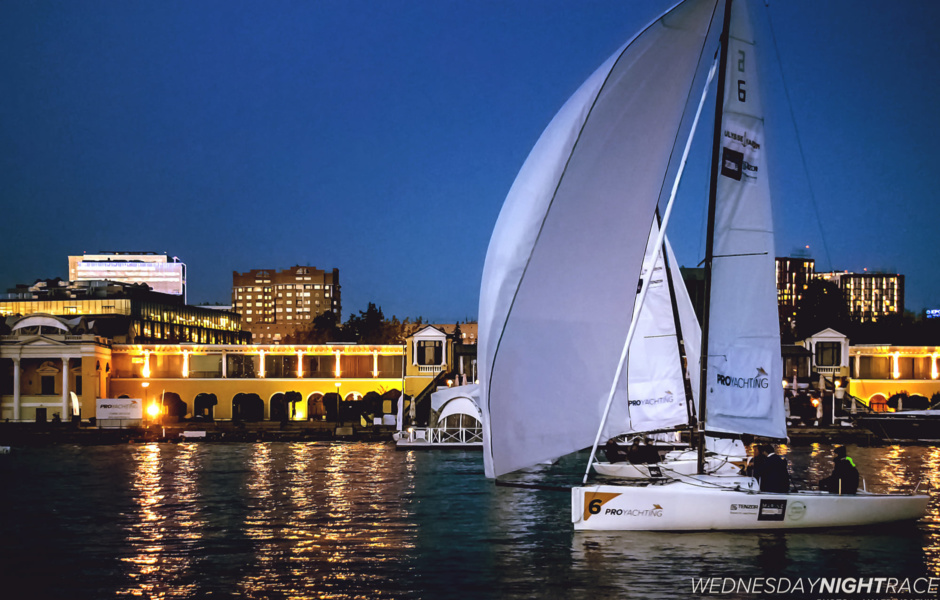
TheCode Zero is an asymmetrical spinnaker especially designed for gybing in slack winds (up to 25% to 8-knot wind). It takes its name from the A0 designation, and is reminiscent of a large genoa with a loose luff. While Code Zero allows to bend the wind effectively on sharp angles, it has some disadvantages: it significantly increases the load on the mast and causes difficulties in cleaning and stowing, as it is made of high-strength composite sailcloths. By the way, the latter circumstance has a significant impact on the price of the sail, that's why it is mainly purchased by professional sailors.
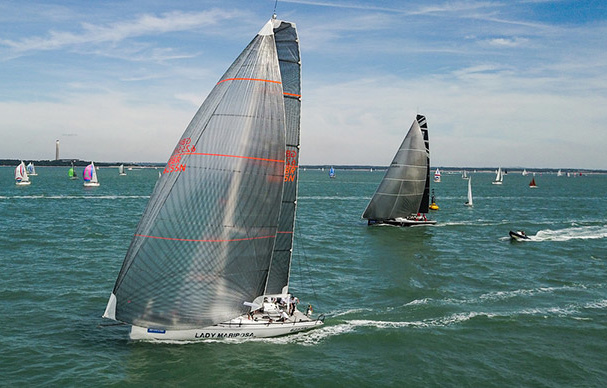
In order to fully use the opportunities of modern sails, you need to determine the scheme of arms and necessary spars which will ensure their really effective operation. In other words, it's necessary to correctly distribute the selected sail area between the bearing structures of the spars. Nowadays relatively small boats with one or two masts are the most available for keen amateur yachtsmen. What are their features, pluses and minuses?
Which is better - one or two masts?
Sailboats differ not only in shape and method of rigging the mainsail, but also in the number of masts, the place where they are set and the number and type of sails used. The most common single-mast boats today are sloop (one fore and one aft sail), tender (two or more fore sails with one aft sail) and cat (only aft sail).
A sloop is a boat with two sails in front (staysail) and behind (mainsail) of a single mast which is set slightly forward from the middle of the hull (midsail). Depending on the ratio of the height of the sails to their width, sloops with long and short aerodynamic profile are distinguished.
The narrower and higher the sail, the steeper to the wind the boat can go. As a rule, sloops of mass series have a medium aerodynamic profile which makes them more convenient to sail even for beginners.
Along with classic (top), sloops with so called fractional rigging are also quite common. In this case, the upper end of the front sail does not reach the very top of the mast (top) by respectively:
- 75% of its height - sloop «three quarters»;
- 85% - sloop «seven-eighths».
«Note that fractional rigging is usually preferred by professional sportsmen, as it allows them to react flexibly to changes in wind strength and direction, more accurately» adjusting the sails during competitions. But there are no rules without exceptions: for example, «little «Lena», on which our glorious compatriot Evgeny Gvozdev made a round-the-world voyage alone, had a 7/8 sloop rigging, and 3.6-meter Acrohc Australis of Australian Serge Testa was a top sloop.
The advantages of sloops in general include:
- Minimal gear.
- Comparative ease of operation.
- Versatile suitability for both racing and family cruising.
As a few disadvantages, they are mostly regarded as significant limitation of leeward visibility with a fully set fore sail (jib). Besides, at some course wind angles (backstag), the sails could be set on the battens and it reduces their effectiveness and, as a consequence, the boat speed. Nevertheless, due to their combined qualities, sloops are very popular among sailors and charter companies alike.

Tender(cutter ) - the mast is usually mounted on the boat's midships, or even slightly shifted in relation to it to the stern. This makes it possible to set two (or even more) forward sails on separate booms instead of one. Depending on the place of attachment of the first of them are distinguished:
- Tenders with bowsprit - a horizontal or sloping spar attached to the bow. This rigging option is typical for boats of larger displacement, in order to increase the forward sail area without increasing the height of the mast.
- Tackless Tenders - the tack of the fore jib is attached directly to the bow of the hull.
Tenders with retractable bowsprit can also be used as a compromise option (usually on custom-built boats). Such designs are especially popular with fans of sailing under the gennaker.
Tenders as a rule yield to sloops as far as possible to tackle the wind. Besides, increasing (due to total fore-sail area) load on the mast requires some extra backstays (booms). But to the absolute advantages of tenders we may refer
- The possibility of flexible selection of a set of sails for any weather.
- Greater efficiency of sails in fair winds.
- Less physical effort when steering and (especially!) when changing sails.
- Improved visibility sector regardless of the course relative to the wind.
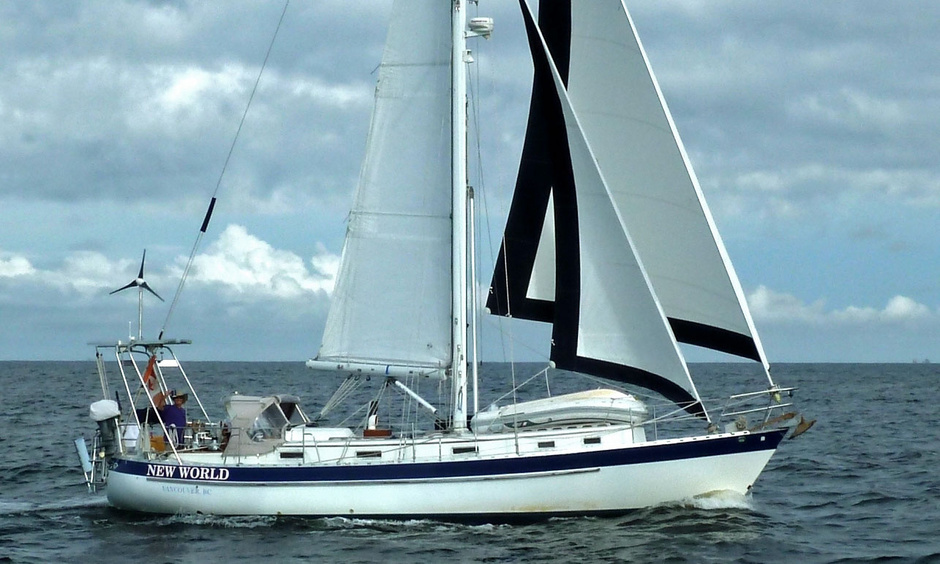
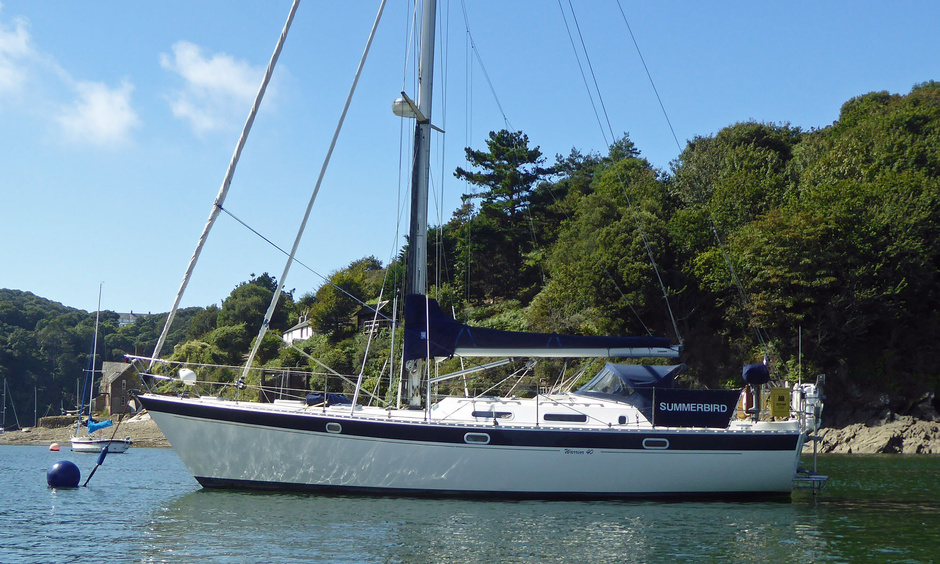
Cat(or kat) - Characterized by a fairly powerful vantage-free mast, maximally forward, and the complete absence of forward sails. The mast is rigidly mounted in the keel step, with the deck console serving as an additional attachment. Although this construction may seem strange, it is not unusual: similar masts have been used in the East for many hundred years already (Chinese junks etc.). The back (and only) sail operates as a wing, and at any course angles, its freedom of movement and possibilities are not restricted by the standing rigging.
It is the wingless mast which defines the main advantages of the ket:
- Significantly reduced weight of the superstructures, hence significantly less roll moment and greater stability.
- A freestanding mast with rigid attachment works more for bending, compensating for excessive sail tension.
- Possibility to drop quickly «» in case of squalls by turning the boom to the bow.
- Easier sail control when changing tack: when you rudder, the boom is thrown to the other side without additional effort.
Theoretically, the lack of headsails should be a significant limitation in case of sharp course wind, however the practice shows that with a skilful handling, even with a single mainsail (with a furler one at that) the boat could outrun a sloop or a tender. In the crosswinds the advantage of a keet over a traditional rigged boat (with comparable waterlines) becomes even more evident.
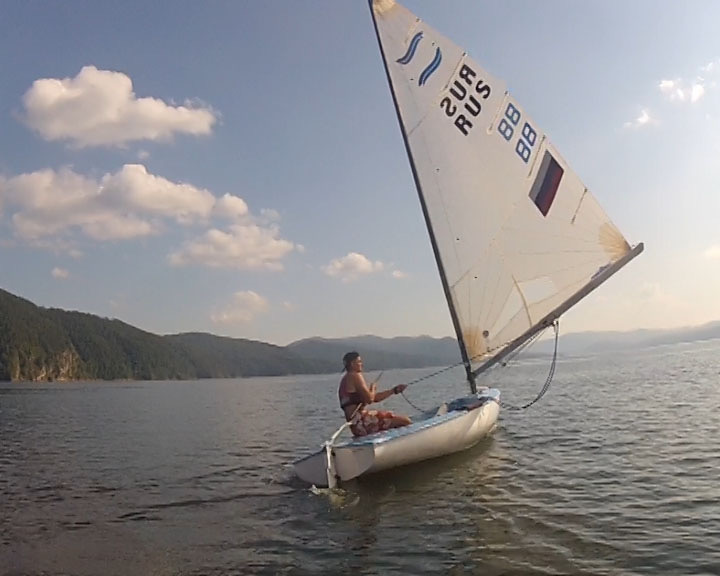
The most popular among modern two-masted boats are ketch, yawl and schooner. They differ in the ratio of foremast to aft mast height and their arrangement.
Kech has the first (mainsail) mast noticeably forward of midships, and the second, bisan-mast is of lower height and set closer to the stern, but in front of the rudder axle (baller). The bisan mast area is of 20-25% of the total sail area, therefore it provides considerable bollard pull together with the mainsail. Like tenders, ketchis can carry two or more sails in front of the first mast (staysails). A similar triangular sail (bisan staysail or apsel), if necessary, is set between the first and second masts, which makes fuller use of even the weakest wind.
As a rule, the sails of the second mast (bisan) and the additional jib are used in passing winds, but when sailing abruptly to the wind they are lowered, so that the ketch practically turns into a tender, and even a sloop (if it goes under one fore-sail).
The main advantages of ketch include:
- The ability to maintain a significant total sail area (and even increase it) while reducing the size of individual sails, making them easier to steer.
- Significantly greater freedom to manoeuvre the sails (both in number and working area) in strong winds than single-mast boats.
- Additional stabilization of the boat at drift, and on a floating or fixed anchor: raised bisan-mast sails help to keep the bow more precisely against the wave.
In addition, a sufficiently high aft mast provides a good location for radar, radar reflector or wind generator. On some ketch the mast tops are additionally connected with a horizontal boom on which it is convenient to place a radio antenna.
However, rigging a rigged sail set and the additional mast makes these boats cost significantly more, but they are much easier to handle than a sloop or tender of the same size. It is no coincidence that Bernard Mouateteau and Robin Knox-Johnston went racing for the Golden Globe in kechas, and that their legendary Joshua and Suhaili were the founders of a family of boats particularly in demand for single-ocean racing.

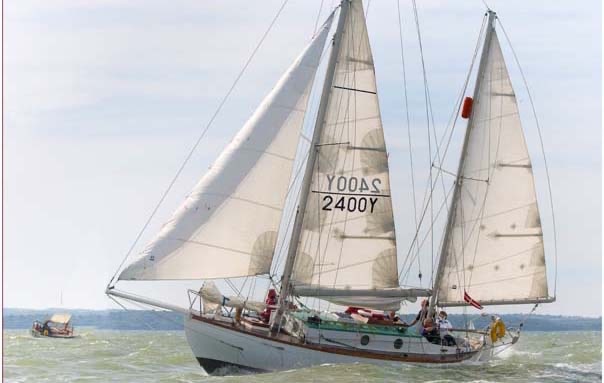
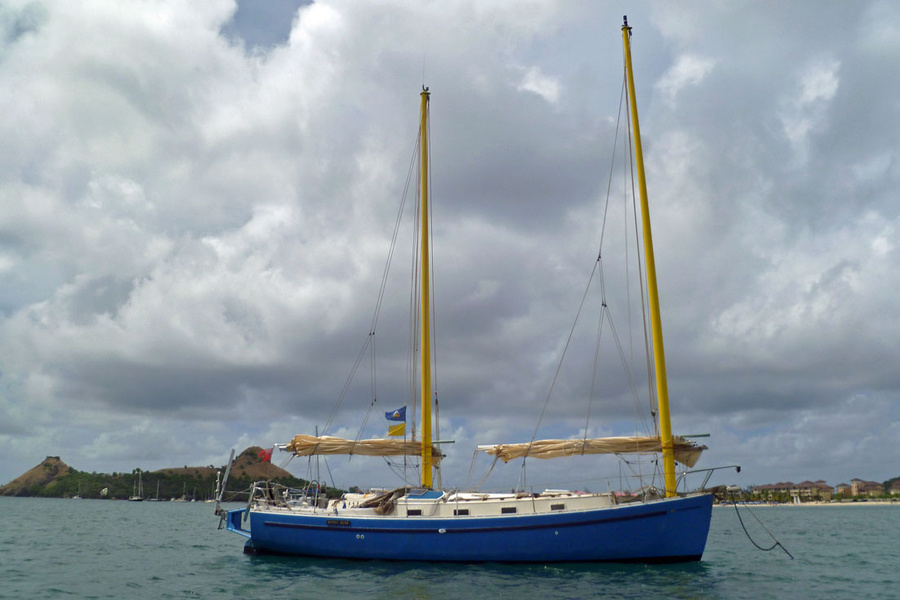
Yawl - unlike ketch, the second mast on this boat is much lower than the first, further aft, and set aft of the helm station. Accordingly, the area of the raised sail (bisan) is smaller and doesn't make the boat look faster even in passing winds. However, the main purpose of a bisan on an yawl is to provide stability on the course, acting as a kind of a windward auto-rudder. Bisail area averages only 10-12% of the total sail area, therefore yolas are sometimes also called «one and a half masted» boats.
Yachting borrowed this version of sailing equipment from the fishing boats of the domotor era, which were important to keep a certain direction of motion while setting/netting, when every pair of free hands was needed for work on deck. The first to adopt the experience of fishermen were single-handed sailors, who were not after speed records. For example, the famous Captain Slocum already converted his Spray (former oyster sloop) into a yoke during his round-the-world voyage.
As more and more advanced autohulls have become available, yoles are gradually losing their popularity with the general mass of sail enthusiasts. However, possessing most of the basic advantages of a kech (including the ability to accommodate additional equipment) at a lower cost, they still find demand among fans of custom designed boats.
Hinckley's modern 48-foot yoke: note the well-developed bisan mast with extras mounted on it
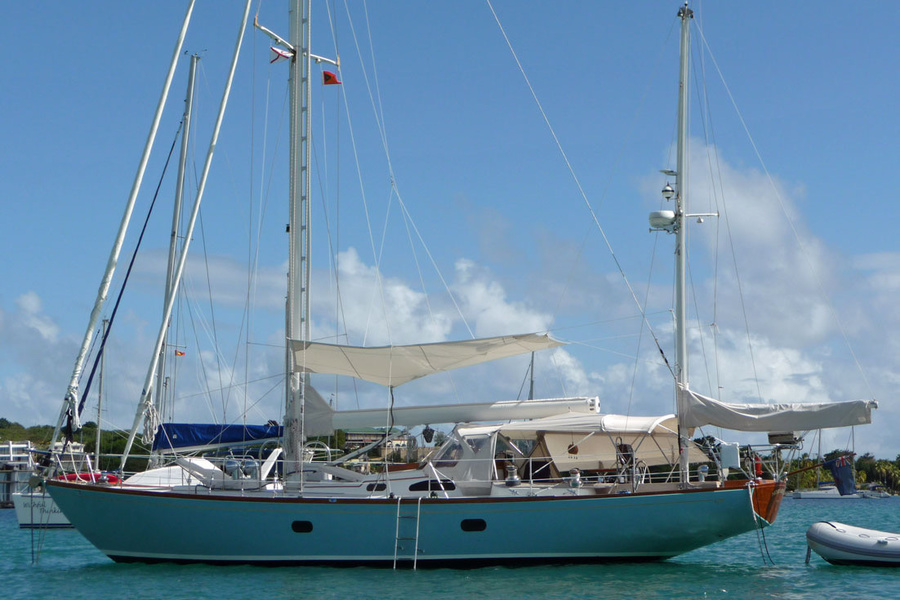
A schooner - the aft mast (mainsail) is equal to or noticeably higher than the foremast (foxtail) in height. Usually pretty big (30ft+) boats are rigged in such a way in modern yachting. Smaller boats are sometimes styled in such a way «like antique». Both (rarely three or more) masts are carrying oblique (triangular) sails only, while straight sails are preserved on relatively large training boats (schooners and brambles). But quite often there are schooners with so called wishbone arms: additional sail (topsail) is raised between foot and main masts. Note, that such variant remains in demand for modern boats: both remodeling of old vessels and new super-projects of class «lux».
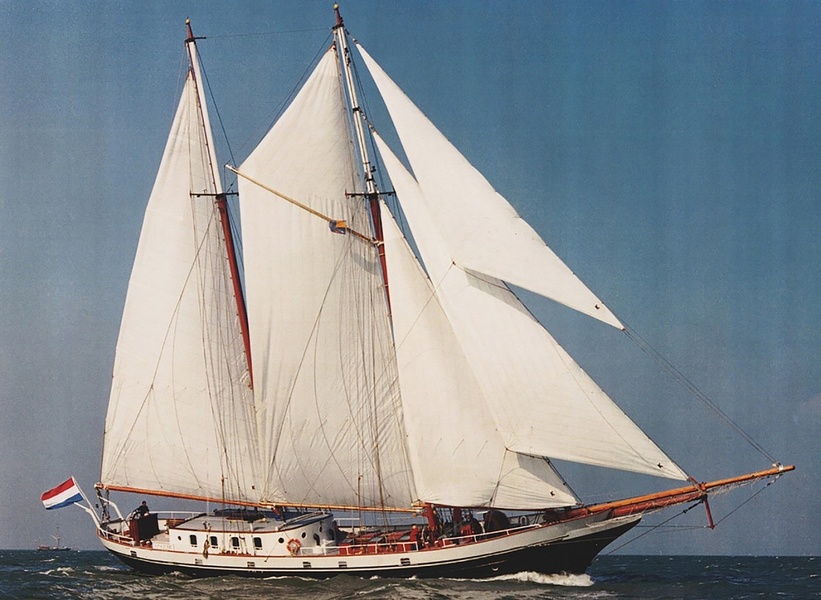
Recognized pros of schooners are:
- Excellent tacking abilities in sharp course wind angles.
- Even greater freedom of maneuvering than other two-masted boats (ketch, yawl) with their sailing «wardrobe».
- The ability to maintain a significant total sail area (and with it, speed) even in stormy weather.
The disadvantages of this type of boat include comparatively lower speeds and unsteadiness of course holding (dawdling) in crosswinds. In addition, with the apparent simplicity of rigging, control of schooner is quite difficult for a relatively small (2-3 people) crew, and even more so for the loner.
To sum up
Independent of financial possibilities you should start your acquaintance with yachting on the boats of modest sizes with simple sailing equipment - for example, cat-boats and small sloops.» Although miniature cats sometimes look «unpretentious», it's on them a beginner has all chances to quickly learn the basic principles of boating, not bothering with an abundance of new terms and «unnecessary (yet) for him ropes and sails.
These boats are good for their versatility and are suitable both for initial training and for developing the acquired skills in long sea and ocean voyages. However, in the pursuit of speed (with an inevitable increase in boat size and sail area), there is a natural need to lighten the spar and reduce the height of the sail centre. So, when total sail area is over 60m², it seems expedient to use tender rigging, which will enable to carry more sails without significant increase of load on a single mast.
A well built and rigged sloop can be sailed and raced for life.
As your skills improve, there is a growing craving for long voyages in comfort and/or achieving greater speeds. Larger boats with a correspondingly larger sail area can provide both. In case of total sail area over 100-120m² it is more effective to use two-mast options of rigging - yola and ketch, and in case of total sail area of 200-250m² and more - schooner.
So, from less to more, from simple to complex, the magic world of sails opens before you.

